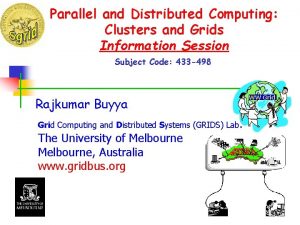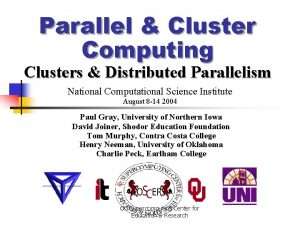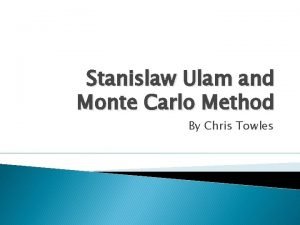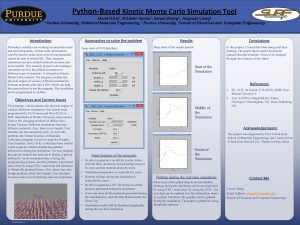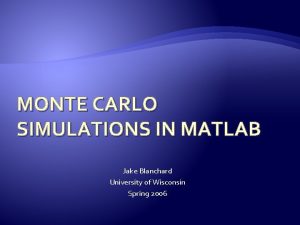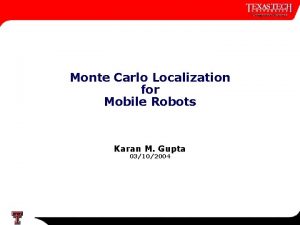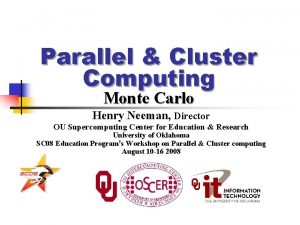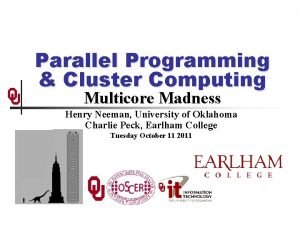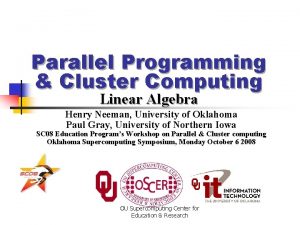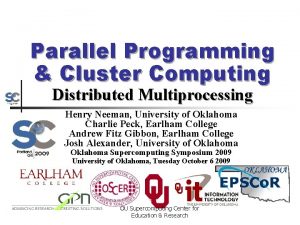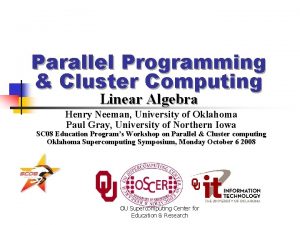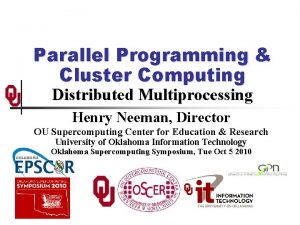Parallel Programming Cluster Computing Monte Carlo Henry Neeman









![Parallel Monte Carlo PROGRAM monte_carlo [MPI startup] IF (my_rank == server_rank) THEN CALL read_input(…) Parallel Monte Carlo PROGRAM monte_carlo [MPI startup] IF (my_rank == server_rank) THEN CALL read_input(…)](https://slidetodoc.com/presentation_image_h/37b0d0724f283c047ef77a88f314ece1/image-10.jpg)


- Slides: 12

Parallel Programming & Cluster Computing Monte Carlo Henry Neeman, University of Oklahoma Paul Gray, University of Northern Iowa SC 08 Education Program’s Workshop on Parallel & Cluster computing Oklahoma Supercomputing Symposium, Monday October 6 2008 OU Supercomputing Center for Education & Research

Embarrassingly Parallel An application is known as embarrassingly parallel if its parallel implementation: 1. can straightforwardly be broken up into roughly equal amounts of work per processor, AND 2. has minimal parallel overhead (e. g. , communication among processors). We love embarrassingly parallel applications, because they get near-perfect parallel speedup, sometimes with modest programming effort. Embarrassingly parallel applications are also known as loosely coupled. SC 08 Parallel & Cluster Computing: Monte Carlo Oklahoma Supercomputing Symposium, October 6 2008 2

Monte Carlo Methods Monte Carlo is a European city where people gamble; that is, they play games of chance, which involve randomness. Monte Carlo methods are ways of simulating (or otherwise calculating) physical phenomena based on randomness. Monte Carlo simulations typically are embarrassingly parallel. SC 08 Parallel & Cluster Computing: Monte Carlo Oklahoma Supercomputing Symposium, October 6 2008 3

Monte Carlo Methods: Example Suppose you have some physical phenomenon. For example, consider High Energy Physics, in which we bang tiny particles together at incredibly high speeds. BANG! We want to know, say, the average properties of this phenomenon. There are infinitely many ways that two particles can be banged together. So, we can’t possibly simulate all of them. SC 08 Parallel & Cluster Computing: Monte Carlo Oklahoma Supercomputing Symposium, October 6 2008 4

Monte Carlo Methods: Example Suppose you have some physical phenomenon. For example, consider High Energy Physics, in which we bang tiny particles together at incredibly high speeds. BANG! There are infinitely many ways that two particles can be banged together. So, we can’t possibly simulate all of them. Instead, we can randomly choose a finite subset of these infinitely many ways and simulate only the subset. SC 08 Parallel & Cluster Computing: Monte Carlo Oklahoma Supercomputing Symposium, October 6 2008 5

Monte Carlo Methods: Example Suppose you have some physical phenomenon. For example, consider High Energy Physics, in which we bang tiny particles together at incredibly high speeds. BANG! There are infinitely many ways that two particles can be banged together. We randomly choose a finite subset of these infinitely many ways and simulate only the subset. The average of this subset will be close to the actual average. SC 08 Parallel & Cluster Computing: Monte Carlo Oklahoma Supercomputing Symposium, October 6 2008 6

Monte Carlo Methods In a Monte Carlo method, you randomly generate a large number of example cases (realizations) of a phenomenon, and then take the average of the properties of these realizations. When the realizations’ average converges (i. e. , doesn’t change substantially if new realizations are generated), then the Monte Carlo simulation stops. SC 08 Parallel & Cluster Computing: Monte Carlo Oklahoma Supercomputing Symposium, October 6 2008 7

MC: Embarrassingly Parallel Monte Carlo simulations are embarrassingly parallel, because each realization is completely independent of all of the other realizations. That is, if you’re going to run a million realizations, then: 1. you can straightforwardly break up into roughly 1 M / Np chunks of realizations, one chunk for each of the Np processors, AND 2. the only parallel overhead (e. g. , communication) comes from tracking the average properties, which doesn’t have to happen very often. SC 08 Parallel & Cluster Computing: Monte Carlo Oklahoma Supercomputing Symposium, October 6 2008 8

Serial Monte Carlo Suppose you have an existing serial Monte Carlo simulation: PROGRAM monte_carlo CALL read_input(…) DO realization = 1, number_of_realizations CALL generate_random_realization(…) CALL calculate_properties(…) END DO CALL calculate_average(…) END PROGRAM monte_carlo How would you parallelize this? SC 08 Parallel & Cluster Computing: Monte Carlo Oklahoma Supercomputing Symposium, October 6 2008 9
![Parallel Monte Carlo PROGRAM montecarlo MPI startup IF myrank serverrank THEN CALL readinput Parallel Monte Carlo PROGRAM monte_carlo [MPI startup] IF (my_rank == server_rank) THEN CALL read_input(…)](https://slidetodoc.com/presentation_image_h/37b0d0724f283c047ef77a88f314ece1/image-10.jpg)
Parallel Monte Carlo PROGRAM monte_carlo [MPI startup] IF (my_rank == server_rank) THEN CALL read_input(…) END IF CALL MPI_Bcast(…) DO realization = 1, number_of_realizations CALL generate_random_realization(…) CALL calculate_realization_properties(…) CALL calculate_local_running_average(. . . ) END DO IF (my_rank == server_rank) THEN [collect properties] ELSE [send properties] END IF CALL calculate_global_average_from_local_averages(…) CALL output_overall_average(. . . ) [MPI shutdown] END PROGRAM monte_carlo SC 08 Parallel & Cluster Computing: Monte Carlo Oklahoma Supercomputing Symposium, October 6 2008 10

To Learn More http: //www. oscer. ou. edu/ SC 08 Parallel & Cluster Computing: Monte Carlo Oklahoma Supercomputing Symposium, October 6 2008 11

Thanks for your attention! Questions? OU Supercomputing Center for Education & Research
 Henry neeman
Henry neeman Henry neeman
Henry neeman Cluster in parallel and distributed computing
Cluster in parallel and distributed computing Distributed, parallel, and cluster computing
Distributed, parallel, and cluster computing Count of monte carlo
Count of monte carlo Stanislaw ulam monte carlo
Stanislaw ulam monte carlo Contoh kasus simulasi monte carlo
Contoh kasus simulasi monte carlo Mnemstudio
Mnemstudio Kinetic monte carlo python
Kinetic monte carlo python Connect 4 monte carlo tree search
Connect 4 monte carlo tree search Monte carlo method matlab
Monte carlo method matlab Monte carlo path tracing
Monte carlo path tracing Monte carlo localization for mobile robots
Monte carlo localization for mobile robots


